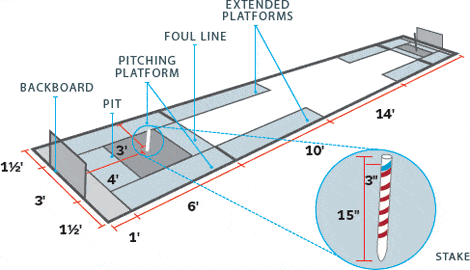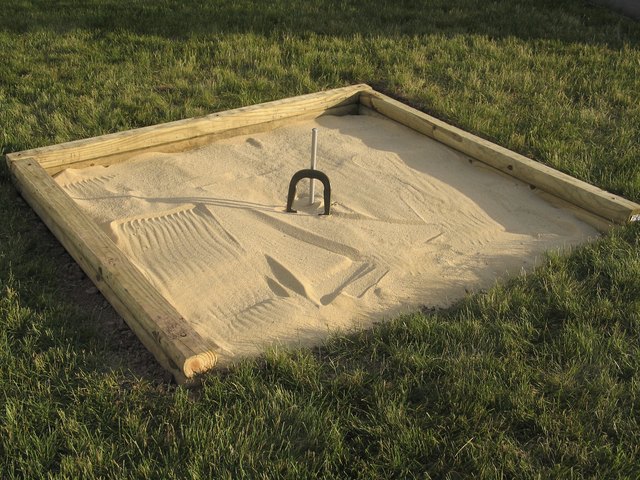Horseshoe Pit Regulation Size
Regulation Horseshoe Pit Dimensions and Diagram in 2020
Horseshoes is a popular outdoor game enjoyed by people of all ages. Whether you're a professional player or just looking for a fun activity to enjoy with friends and family, it's important to understand the regulation horseshoe pit dimensions and guidelines. In this article, we will provide you with all the essential information you need to know about the regulation size of a horseshoe pit in 2020.
1. Understanding the Regulation Dimensions

Before we delve into the details of the regulation dimensions, let's take a moment to understand why they are so crucial. The official dimensions ensure fairness and consistency in the game, allowing players to compete on a level playing field. Here are the regulation horseshoe pit dimensions you need to follow:
- The overall dimension of a horseshoe pit should be 46 feet long and 6 feet wide.
- Each pit is divided into two pitching platforms that measure 6 feet by 6 feet.
- The stakes in a horseshoe pit are placed 40 feet apart from each other.
By adhering to these guidelines, you can ensure that your horseshoe pit meets the official standards and provides the best possible experience for all players.
2. Constructing a Regulation Horseshoe Pit

Now that you understand the dimensions, let's explore how to construct a regulation horseshoe pit step by step:
A. Finding the Perfect Location
The first step is to find a suitable location for your horseshoe pit. It should be an open and level area with enough space to accommodate the full dimensions. Ensure that there are no obstructions or hazards nearby that could interfere with the game.
B. Marking the Playing Area
Once you've chosen the location, mark the boundaries of the horseshoe pit using stakes and string. The overall dimensions should be 46 feet in length and 6 feet in width. Make sure the lines are clear and visible.
C. Dividing the Pit
Next, divide the pit into two pitching platforms. Each platform should measure 6 feet by 6 feet. You can use additional string or markers to indicate the division.
D. Installing the Stakes
Finally, install the stakes at each end of the horseshoe pit. The stakes should be placed exactly 40 feet apart from each other, measured from the front of each pitching platform. Ensure that the stakes are securely anchored in the ground to maintain stability during play.
By following these steps, you can create a regulation horseshoe pit that meets the official standards and provides an enjoyable experience for everyone.
3. Frequently Asked Questions
Q1: Can I customize the design of my horseshoe pit?
A1: While it's important to adhere to the regulation dimensions, you can certainly get creative with the design of your horseshoe pit. Consider adding landscaping elements, such as decorative rocks or flower beds, to enhance the aesthetic appeal of your playing area.
Q2: Are there any specific materials I need to use for constructing a horseshoe pit?
A2: The choice of materials is flexible. You can use materials like clay, sand, or synthetic turf for the pitching platforms. As for the stakes, they are usually made of metal or durable plastic. Just ensure that the materials you choose are durable, safe, and provide good traction.
Q3: Can children participate in the game of horseshoes?
A3: Absolutely! Horseshoes is a game that can be enjoyed by people of all ages. However, it's essential to supervise young children to ensure their safety during play. Use lightweight horseshoes specifically designed for children to minimize the risk of accidents.
Now that you have a comprehensive understanding of the regulation horseshoe pit dimensions and guidelines, you're ready to create your own professional-grade horseshoe pit! Remember to always prioritize safety and fair play while enjoying this exciting and competitive game.
Horseshoe Pit! Supposed To Be 6'x48' For A Full Professional Court, But
 Image Source : www.pinterest.co.uk
Image Source : www.pinterest.co.uk horseshoe pits pitching sheffield regulation cubic
How To Build A Horseshoe Pit | How-tos | DIY
horseshoe pit build dimensions backyard diy games diagram size horseshoes plans game horse outdoor pits diynetwork official measurements shoe rules
Horseshoe Pit Dimensions - Everything You Need To Know – Go Sports Fantasy
 Image Source : gosportsfantasy.com
Image Source : gosportsfantasy.com How To Build A Regulation Horseshoe Pit | Livestrong.com
 Image Source : www.livestrong.com
Image Source : www.livestrong.com horseshoe pit build horseshoes horse shoe game regulation backyard make pits dimensions area games simple diy shoes building court outdoor
How To Build A Horseshoe Pit
 Image Source : homefixated.com
Image Source : homefixated.com horseshoe regulation pits attract drinking nhpa homefixated
All About The Game Of Horseshoes – Wizard Of Yards
 Image Source : wizardofyards.com
Image Source : wizardofyards.com bocce horseshoes horseshoe croquet horsehoes pits popularmechanics substance sand mechanics courts shuffleboard legal recommended o06
Horse Shoe Pit Dimensions | Horseshoe Pit Dimensions, Horseshoe Pit
 Image Source : www.pinterest.com
Image Source : www.pinterest.com horseshoe shoe regulation horseshoes bocce
Regulation Horseshoe Pit Dimensions And Diagram In 2020 | Horseshoe Pit
 Image Source : www.pinterest.com
Image Source : www.pinterest.com horseshoe regulation
Horseshoe pit! supposed to be 6'x48' for a full professional court, but. Regulation horseshoe pit dimensions and diagram in 2020. Horseshoe pit dimensions. How to build a horseshoe pit. Horseshoe pit build dimensions backyard diy games diagram size horseshoes plans game horse outdoor pits diynetwork official measurements shoe rules